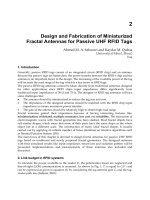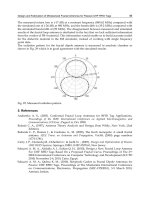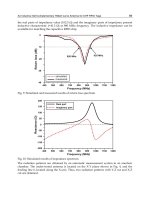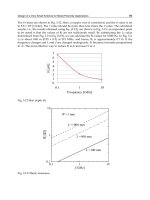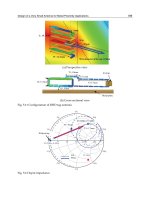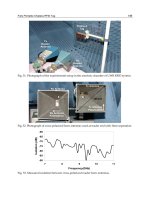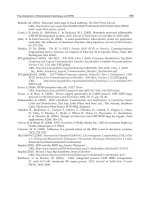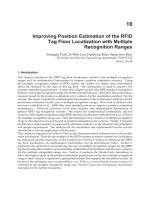Advanced Radio Frequency Identification Design and Applications Part 1 ppt
Bạn đang xem bản rút gọn của tài liệu. Xem và tải ngay bản đầy đủ của tài liệu tại đây (309.24 KB, 20 trang )
ADVANCED RADIO
FREQUENCY
IDENTIFICATION
DESIGN AND
APPLICATIONS
Edited by Stevan Preradović
Advanced Radio Frequency Identification Design and Applications
Edited by Stevan Preradović
Published by InTech
Janeza Trdine 9, 51000 Rijeka, Croatia
Copyright © 2011 InTech
All chapters are Open Access articles distributed under the Creative Commons
Non Commercial Share Alike Attribution 3.0 license, which permits to copy,
distribute, transmit, and adapt the work in any medium, so long as the original
work is properly cited. After this work has been published by InTech, authors
have the right to republish it, in whole or part, in any publication of which they
are the author, and to make other personal use of the work. Any republication,
referencing or personal use of the work must explicitly identify the original source.
Statements and opinions expressed in the chapters are these of the individual contributors
and not necessarily those of the editors or publisher. No responsibility is accepted
for the accuracy of information contained in the published articles. The publisher
assumes no responsibility for any damage or injury to persons or property arising out
of the use of any materials, instructions, methods or ideas contained in the book.
Publishing Process Manager Katarina Lovrecic
Technical Editor Teodora Smiljanic
Cover Designer Martina Sirotic
Image Copyright Albert Lozano, 2010. Used under license from Shutterstock.com
First published March, 2011
Printed in India
A free online edition of this book is available at www.intechopen.com
Additional hard copies can be obtained from
Advanced Radio Frequency Identification Design and Applications,
Edited by Stevan Preradović
p. cm.
ISBN 978-953-307-168-8
free online editions of InTech
Books and Journals can be found at
www.intechopen.com
Part 1
Chapter 1
Chapter 2
Chapter 3
Chapter 4
Chapter 5
Chapter 6
Chapter 7
Chapter 8
Part 2
Chapter 9
Preface IX
Advanced RFID Tag Design 1
Operating Range Evaluation of RFID Systems 3
Peter. H. Cole, Zhonghao Hu and Yuexian Wang
Design and Fabrication of Miniaturized
Fractal Antennas for Passive UHF RFID Tags 29
Ahmed M. A. Sabaawi and Kaydar M. Quboa
Design of RFID Coplanar Antenna
with Stubs over Dipoles 51
F. R. L e Silva and M. T. De Melo
An Inductive Self-complementary
Hilbert-curve Antenna for UHF RFID Tags 63
Ji-Chyun Liu, Bing-Hao Zeng and Dau-Chyrh Chang
Design of a Very Small Antenna
for Metal-Proximity Applications 77
Yoshihide Yamada
Using Metamaterial-Based Coplanar Waveguide Structures
for the Design of Antennas on Passive UHF RFID Tags 115
Benjamin D. Braaten and Masud A. Aziz
Fully Printable Chipless RFID Tag 131
Stevan Preradovic and Nemai Karmakar
The Interaction of Electrostatic Discharge and RFID 155
Cherish Bauer-Reich, Michael Reich and Robert Nelson
Advanced RFID Applications 171
Privacy-enhanced RFID Tag Search System 173
Ji Young Chun, Jung Yeon Hwang and Dong Hoon Lee
Contents
Contents
VI
Improving Position Estimation of the RFID Tag Floor
Localization with Multiple Recognition Ranges 189
Youngsu Park, Je Won Lee, Daehyun Kim and Sang-woo Kim
Pseudorandom Tag Arrangement
for Accurate RFID based Mobile Robot Localization 207
Sungbok Kim and Hyunbin Kim
RFID Tags to Aid Detection
of Buried Unexploded Ordnance 221
Keith Shubert and Richard Davis
Reordering of Location Identifiers
for Indexing an RFID Tag Object Database 245
Sungwoo Ahn and Bonghee Hong
An Efficient Cut-through Mechanism
for Tree-based RFID Tag Identification Schemes 259
Nai-Wei Lo and Kuo-Hui Yeh
Design and Implementation of a Multi-protocol
UHF RFID Tag Simulation Platform 269
Bo Zhang, Dongkai Yang and Qishan Zhang
Chapter 10
Chapter 11
Chapter 12
Chapter 13
Chapter 14
Chapter 15
Pref ac e
Radio Frequency Identifi cation (RFID) is a modern wireless data transmission and re-
ception technique for applications including automatic identifi cation, asset tracking
and security surveillance. As barcodes and other means of identifi cation and asset
tracking are inadequate for recent demands, RFID technology has a racted interest for
applications such as logistics, supply chain management, asset tracking, and security
access control. Due to the fl exibility and numerous advantages of RFID systems com-
pared to barcodes and other identifi cation systems, RFID is now becoming crucial for
mass market.
Patronization of RFID technology by major retail chains like Wall Mart, K-Mart, USA
Department of Defence, and similar consortia in Europe and Asia has accelerated the
progress of RFID technology signifi cantly in the new millennium. As a result, sig-
nifi cant advancement on RFID technology has been gained within a short period of
time. This book focuses on the advances in RFID tag antenna and ASIC design, novel
chipless RFID tag design, security protocol enhancements along with some novel ap-
plications of RFID.
The book is divided into two sections. The fi rst section of the book presents the theory
and design of RFID tags – physical layer. The second section of the book focuses on
novel RFID applications as well as tag-to-reader communications protocol develop-
ment and enhancement.
Since most RFID tags comprise of an antenna and chip (ASIC), the design of both are
presented in the fi rst section of the book. The initial chapter presents the basic the theo-
retical concepts of RFID and also introduces the operating range evaluation of RFID
systems since reading range is an important factor when installing an RFID system. The
following chapters focus on tag antenna design. The most commonly used antenna for
RFID tags is the dipole antenna and a novel technique for matching the antenna imped-
ance with the input impedance of the ASIC is presented. Following are novel antenna
structures based on miniaturized fractal and Hilber-curve antennas and metamaterial
based antennas. Novel fractal structures and metamaterials enable the minituarization
of passive UHF tag antennas compared to those that can be found on the market. The
design of novel small antennas for metal proximity use is presented with a comprehen-
sive parametric study focusing on the design concepts of these antennas.
X
Preface
Following the chapters focusing on tag antenna design are chapters which present a
low-power baseband processor for UHF passive tags and the interaction of electro-
static discharge and RFID which is hardly ever presented in RFID books but plays an
important role in any digital circuit design. The fi rst section of the book is fi nalized by
a chapter focusing on a new and exciting type of RFID called Chipless RFID. Chipless
RFID has the potential to replace the barcode since it has no ASIC for it. In this book, a
fully printable chipless RFID tag based on multiresonators is presented, which encodes
data into the spectrum therefore creating its own spectral signature.
The second section of the book focuses on new and advanced applications of radio
frequency identifi cation. The second section starts with one of the most common ap-
plications of RFID – privacy and product maintenance and tracking. In the fi rst chapter
of the second section the RFID protocols and their classifi cation are presented. Previ-
ously presented works on security and managing hacking a acks on RFID systems are
surveyed and new techniques and measures in increasing the privacy of RFID systems
are presented. The following chapters focus on the use of RFID for localisation and
positioning applications. Novel applications such as the use of RFID for mobile robot
positioning and the detection of unexploded ordnance at military fi ring ranges are
presented. Advances in RFID tag identifi cation processes and protocols at the RFID
reader end along with the reordering of localisation objects for RFID tag databases are
presented. The second section of the book is fi nalized with the design and implemen-
tation of a multi-protocol UHF RFID platform which enables the designers to have an
almost universal test platform before actual RFID system implementation is conducted
in order to save cost.
This book is intended for readers who are already familiar with RFID and wish to gain
information on novel designs and cu ing edge RFID technology. This book also pro-
vides substantial theoretical and technological background and explanation of RFID
for those readers who are new to the fi eld of RFID and wish to embark into this exciting
and ever expanding fi eld.
Stevan Preradović
Monash University,
Australia
Part 1
Advanced RFID Tag Design


